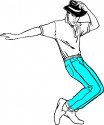Becoming A Dancing Choreographer

If you ever watch the ballet or any other kind of dance, you might think that the dancers’ movements come naturally. They might seem to flow out of what the dancers are thinking or feeling as they try to tell a story or show emotion with how they bend their arms or move their legs. If you take dance lessons, however, you know better. You know that in most dance performances, choreographers have carefully planned each movement that the dancers make. A good choreographer works in the background to make sure that the combination of dancing and music create an experience that the audience, musicians, and dancers will all enjoy and appreciate.
Many people can probably name at least one or two famous dancers they have seen or at least heard about through newspapers or television. Very few of them, however, are likely to be able to name even one choreographer. That’s because choreography is not really supposed to be seen. Choreographers who do their jobs well and who work with good dancers produce a performance where the dance seems to flow out of the music naturally and doesn’t seem forced or awkward. Whether the dancers leap into the air or stand on their toes and twirl around, the movements have to seem to come out of the story they are trying to tell, with music as the unifying background.
Being able to tie movement, story, and music together takes a lot of skill and practice. One of the best-known choreographers of the twentieth century, Martha Graham, was able to make music and dance work together. She had many chances to practice her skills in her seventy-year career. Her father was a doctor who believed that the body and mind were closely connected. He recommended physical movement as a cure for nervous diseases for his patients. However, he would not allow his daughter to learn how to dance.
Later on, Martha studied and then taught at the Denishawn School of Dancing and Related Arts in California. She was especially interested in modern dance, and she choreographed many performances over the next years. Like most other people in her field, Martha Graham learned choreography through a combination of education and experience.
Choreographers usually start out as dancers, learning the basics of movement from other people in the group. When they know enough about dancing and the limits of what dancers are able to do, often after about five years, they can start choreographing dances. Many people also get an education in the fine arts, music, or related subjects before they begin on their careers. Others gain experience through working with dance companies and learning from other choreographers.
Dancing is a physically demanding job, and most dancers stop quite young. However, working as a choreographer is a good way for people who love dancing to continue to work in their chosen field.





Leave a comment!